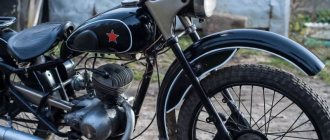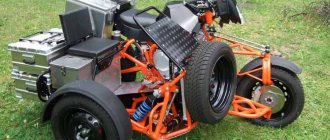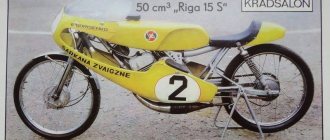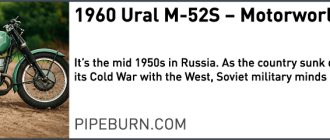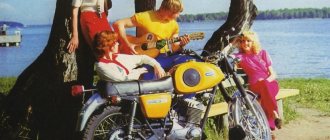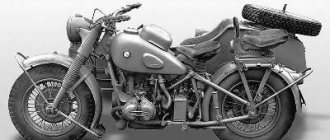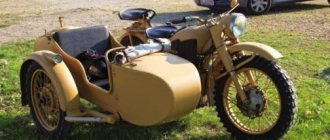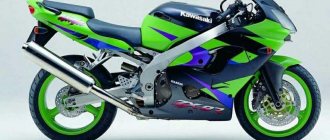Why did they stop producing the IZH Planet motorcycle in Russia? Oddly enough, the Kovrov Machine-Building Plant named after Dektyarev (ZID), as well as the former Soviet, now Belarusian Minsk Motorcycle Plant, still supply their motorcycles to the market. As for the Izhevsk Machine-Building Plant, which produces IZH motorcycles (Planet, Planet-Sport, Jupiter), the last production batch of motorcycles was produced in 2008, then, due to difficulties arising from the economic crisis, the production of IZH motorcycles was curtailed. It’s a pity, because the state could have provided assistance to the plant. At that time, Izhmash had a lot of experimental design work on promising motorcycles, both with two-stroke and four-stroke engines. I have a lot of positive memories associated with the IZh “Planet-3” and “Planet-5” motorcycles.
Any motorcycle model starting from Planet-2 gave a head start to Jupiters in terms of cross-country ability, old or new, it doesn’t matter. He didn’t sail on it, even in the taiga or in the forest, fishing or hunting. A very reliable “workhorse” with traction like a tractor, and my father and I never transported anything on it. We bought it in 1989 and to this day my father drives it, but it looks like new and makes my heart happy with its proper operation. Planet motorcycles, even its oldest models, continue to serve their owners regularly and reliably, despite the stoppage of production, there are no problems with spare parts for repairs on the market, and there is no limit to the maintainability stock. In this article, we will look at the IZH-P5 power unit of the IZH Planet 5 motorcycle, or more precisely, its technical characteristics, weaknesses and disadvantages. The IZH-P5 power unit differs from the IZH-P4 20 hp. the previous model of the motorcycle “IZH Planety-4” increased by 2 hp. power, a higher compression ratio and an engine head, the 4th model has two exhaust pipes, the 5th has one. Gearboxes differ in the number of teeth on the gears and, accordingly, in the gear ratios. Gearboxes are interchangeable.
Characteristics of the IZH-P5 motor
| engine's type | Single-cylinder, carburetor, two-stroke, air cooled. |
| Working volume, cm3 | 346 |
| Maximum power, l. With. | 22 (20.9…23.1 at 4850±10% rpm |
| Cylinder diameter, mm | 72 |
| Piston stroke, mm | 85 |
| Compression ratio | 8,2-8,7 |
| Cylinder-piston group lubrication system | mixture of fuel and oil. On later motorcycle models, oil supply is used by an oil pump, which proportions the oil supply depending on the crankshaft speed and engine load in ratios of 1/25-1/100 to the gasoline supply. The filling capacity of the Izh P-5-01 motorcycle engine crankcase is 0.7 l, oil M-8V, M-10V2, MS-14, MS-20, MGD-14M or their foreign analogues. |
| Carburetor | K-65I (in earlier ones - K-62I) |
| Fuel used | motor gasoline with an octane number of at least 76. With a joint lubrication system, gasoline is used in a mixture with motor oils M-8V, M-10V, aviation oil MS-20 in a ratio of 25: 1, or a mixture of gasoline and oil for two-stroke engines MGD-14M (or its foreign analogues) in a ratio of 50:1. |
| Gas tank capacity | 18 l. |
| Air filter | contact-oil |
| Oil filling capacity in the air filter | 0.15 l engine oil |
| Generator | Generator - a three-phase electric machine with electric machine excitation and an electronic rectifier-voltage stabilizer BPV-14-10 (BPV-21-15), with a power of initially 100, then 140 W, or a single-phase generator with excitation from permanent magnets and an electronic regulator RNM-1, power 90 W. |
| Ignition | battery contact capacitor, on later models electronic non-contact, with automatic control of ignition timing based on crankshaft speed and independent of the battery. |
| Spark plug | A23B (or foreign analogues) |
| Accumulator battery | lead acid, type 6MTS-9, 12 volt 9 Ah |
| Transmission | |
| Transfer from engine to clutch | double-row bushing drive chain (reinforced) in an oil bath |
| Clutch | multi-disc in oil bath |
| Gearbox housing filling capacity | 1.0 l, oil M-8V, M-10V2, MS-14, MS-20 or their foreign analogues. |
| Transmission | three-shaft four-speed in one unit with engine and foot gear shift. |
| Transmission from gearbox to rear wheel | closed bushing single row chain |
| Gear ratio from engine to clutch | 2,17 |
| Gear ratio from gearbox to rear wheel | 2,33 |
| Gearbox ratios in gears: | |
| I | 3,88 |
| II | 2,01 |
| III | 1,26 |
| IV | 1,0 |
Izh history of motorcycles from the Izhmash plant
The history of motorcycles began thanks to the legendary engineer and avid motorcyclist Pyotr Vladimirovich Mozharov, who for the first time in the Soviet Union became the organizer of motorcycle production. Back in 1928, Pyotr Vladimirovich submitted an official proposal to organize the production of high-quality and fast motorcycles at Izhstalzavod. The engineer achieved his goal and after some time at Izhstalzavod in Izhevsk, a separate design bureau was created, which was engaged in the production, design of motorcycles and their first testing.
Photo of the IZH-1 motorcycle
In 1932, a commission was created, by whose decision the first samples of the IZH-1 and IZH-2 motorcycles were prepared; it was then that the decision to organize the Izhevsk Machine-Building Plant was first made. Production proceeded by leaps and bounds, it seemed that the history of IZH motorcycles did not end and would never end! Already in 1933, production of IZH-7 began. This motorcycle model was modified, improved, with new functionality; it was a variant of the German L-300. By the way, IZH-7 can still be found today; thanks to high-quality assembly, such “machines” can operate for decades.
Photo of the IZH-7 motorcycle
During the Great Patriotic War, the production of Izhevsk motorcycles was sluggish. Unfortunately, mass production of IZH motorcycles for non-military purposes continued only in 1946. In 1945, after the end of the war, another design group was assembled and set to work creating new IZH motorcycles, but everything turned out to be much simpler than everyone thought. After some time, drawings and technical documentation for the DKV “NTs-350” motorcycle were brought from Germany and the designers made a decision: not to change anything, to start producing the new IZH-350 motorcycle. Of course, soon there was a modernization, which revealed numerous errors of the German motorcycle and a completely new vehicle, of native domestic production, began to be called IZH-49 and went out of production in a short time.
Photo of the IZH-49 motorcycle
By the end of the 70s of the last century, Izhevsk became a motorcycle city that produced more than 350 thousand motorcycles per year! In the 80s, sports motorcycles began to be produced, which were intended primarily for road racing and various cross-country competitions. Motorcycles from Izhevsk gained particular popularity when the plant began to produce models such as “Izh-Jupiter”, “Izh-Planeta”, “Izh-Yunker”, “Izh-Planet Sport”.
Photo of the IZH Jupiter-5 motorcycle
In conclusion, I would like to note that today the domestic motorcycle market is rather weak competition for many global manufacturers. This applies not only to design solutions, but also to technical equipment. However, despite their irrelevance, and thanks to low prices, simplicity of design, control and quality, Izhevsk motorcycles are still relevant among the people.
I invite you to watch a video about the IZH motorcycle museum
Weaknesses of the IZH-P5 engine
- Air filter;
- Cylinder-piston group;
- Transmission.
More details about the weak points of the IZH-P5 power unit...
Air filter. To prevent dust from entering the engine, frequent washing and oiling of the filter element is required. Installing a paper filter would reduce the time spent on engine maintenance during maintenance and would improve the quality of cleaning the air supplying the carburetor.
The CPG wears out after 20,000-25,000 km due to the lack of water cooling.
Transmission. Over the years, due to wear and tear, the gears switch off on their own and adjustment does not eliminate the problem. In this case, it is necessary to overhaul the gearbox and replace worn out parts.
Disadvantages of the IZH-P5 engine
- Loud in operation;
- Increased vibration;
- Oil sprays from the muffler;
- Long acceleration;
- High fuel consumption;
- Small resource;
- Strong return from kickstarter.
Loud operation has a negative impact on people around (interferes with rest), which causes corresponding reactions towards the motorcyclist.
Increased engine vibration is felt throughout the motorcycle, especially with your hands on the handlebars.
Oil splashes from the muffler, which falls on the back of the driver or passenger when driving. This disadvantage is eliminated by installing a stainless steel ladle of the appropriate diameter at the end of the exhaust pipe. The ladle should have a sector cut out in advance, which should be in the lower part when mounted with screws. This modification will prevent oil from getting onto the back, and the exhaust will be directed downward.
Long acceleration. Planet 5 with a sidecar takes longer to accelerate. The increased duration during acceleration is especially noticeable on a motorcycle with a sidecar.
High fuel consumption. The engine is not fuel efficient and the reason is primarily in the design of the two-stroke engine.
The resource is limited to an interval of 20-25 thousand km
Strong return from kickstarter. To prevent the kickstarter from hitting your leg, do not accompany the kickstarter with your foot when it returns to its original position. The impact on the kickstarter when starting the engine should be sharp and strong.
Conclusion.
The engine is reliable and simple, rarely breaks down. Easy to repair. Its production has stopped, but there are no problems with spare parts. The cylinder is not disposable; it can be repaired by boring or replacing liners with the installation of assembled repair pistons (to fit the repair dimensions of the cylinders). The engine is not for sports racing, but for farming in rural areas and for going out into nature it has no price, it is good.
PS. Dear “Planetovod” motorcyclists! You can ask a question or add reviews and information on the weak points and shortcomings of the IZH-P5 motor in the comments.
Soviet motorcycles for ShKMG, part 23: IZH - Sh 11.
In 1969, the Izhevsk Motorcycle Plant began production of the Sh 11 model. This motorcycle left a noticeable mark on domestic motorsports and served as the basis for subsequent models - Sh 12 and 6.217.
The need for such a motorcycle was long overdue - athletes needed a motorcycle that would be produced, if not in large quantities, but at least in small series. By the early seventies, the Serpukhov plant had moved away from motorsports, and other manufacturers showed no interest in the production of racing motorcycles. This situation forced athletes to perform on outdated equipment or even use homemade designs. For example, an article in the magazine “Behind the Wheel” talks about one of these motorcycles. Its creators, the great Jüri Randla and Endel Kiisa, need no introduction.
Sh 11 was an almost completely original design; with serial IZHs it was only related to the engine crankcase, crankshafts, and some gearbox parts, as well as small parts, such as levers on the steering wheel, chains and cables. The frame, wheels, brakes, and the entire body kit were made specifically for Sh 11 and were original. The lower cups of the front fork were shortened by 40 mm, and its stroke was reduced. The rear shock absorbers have also been modified for racing use. The cylinders and heads, although they had a design similar to the parts of Jupiter 2, were very different. The number of gear ratios in the gearbox has been changed. The ignition remained cam, but was powered by a battery; the generator was excluded from the design.
Illustration from the magazine “Behind the Wheel” for July 1970.
The engine power, thanks to the use of different valve timing, heads with a higher compression ratio, other pistons and resonators, was 35 hp. , while Jupiter 2 had 26, but plant representatives claimed that it could be raised to 45 or even 50 hp. On later IZH-Sh 11, the basis for the engine was Jupiter 3.
The photographs show a pre-production prototype of the IZH-Sh 11.
19-inch wheels, brake drums with a diameter of 200 mm. Double-cam brakes, reinforced brake cables.
The exhaust system consisted only of resonators; the factory did not provide mufflers. However, the riders, of course, made changes within the rules.
IZH Sh 11 gave the opportunity to engage in motorsports to a wider range of people. The country's best riders, such as Lembit Teesalu, competed on Sh 11.
Lembit Teesalu on IZh - Sh 11. The motorcycle was modified by the production association for the production of sports equipment "Vihur" of the Central Committee of DOSAAF USSR in Tallinn, from what can be seen in the photo - it has a different fairing, tank and tail.
IZH - Sh 11.
IVARS BLUMFELDS racer, 1978.
The IZH-Sh 11 was produced until 1974, after which its production was discontinued and it was replaced by the IZH-Sh 12. Now the IZH-Sh 11 is a very rare motorcycle, but it can be seen in museums and private collections in Russia and abroad.
IZH - Ш 11, sold on E Bay in 2013, further fate is unknown.
IZh - Ш 11 from Mootorispordi Muuseum, Estonia.
Another IZH is Sh 11 from Estonia.
IZH-Sh 11 1972 produced by our friend from Latvia Edgars.
IZH - Ш 11 from the collection of the museum of the UMMC plant in Verneya Pyshma.
